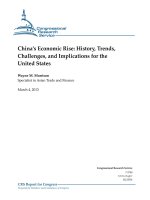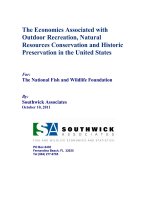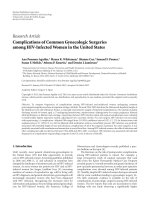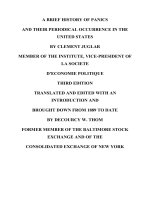Basic Legal English 2 The Common Law In The United States.pdf
Bạn đang xem bản rút gọn của tài liệu. Xem và tải ngay bản đầy đủ của tài liệu tại đây (5.78 MB, 14 trang )
<span class="text_page_counter">Trang 1</span><div class="page_container" data-page="1">
MINISTRY OF JUSTICE
<b>HANOI LAW UNIVERSITY</b>
<b>GROUP WORK</b>
<b>MID-TERM ASSIGNMENTCOURSE:</b>
<b>Basic Legal English 2</b>
<b>The common law in the United States</b>
<b>Major: Legal English Class: 4625 – N02Group: 07</b>
<b>Hanoi, 2023</b>
</div><span class="text_page_counter">Trang 2</span><div class="page_container" data-page="2"><b>MINUTE DETERMINING THE INVOLVING LEVEL ANDPARTICIPATION RESULTS IN GROUP WORK ACTIVITIES</b>
<b><small>Total number of students in the group:</small></b>
<small>+ Attended: 4+ Absented: 0</small>
<b><small>Course: Basic Legal English</small></b>
<b><small>Topic: The common law in the United State</small></b>
<small>Determining the level of participation and results of each student's participation in theinvolvement of group work activities, the outcomes are as follows:</small>
<b><small>FULL NAME</small></b>
<b><small>Students’ </small></b>
<small>1.462534Trần Lê Ngọc MinhX2.462535Nguyễn Thị Trà MyX3.462544Lê Thị Phương ThanhX4. 462554Bùi Mai UyênX</small>
<small>+ The first teacher’s assessment:………</small> <b><small>GROUP LEADER</small></b>
<small>+ The second teacher’s assessment:………</small>
<small>- The result of the presentation:………</small>
<small>- Teacher grading the presentation:………</small>
<small>- The overall grade:………</small>
<small>- The final assessment of the teacher:………i</small>
</div><span class="text_page_counter">Trang 3</span><div class="page_container" data-page="3"><b>II. T<small>HE DEVELOPMENT OF</small> C<small>OMMON</small> L<small>AW IN THE</small> US</b>...3
<i>1. The growth of statute law and codes...3</i>
<i>2. Federal and state judicial systems...3</i>
<i>3. Personal and property rights through the years have been approved...4</i>
<b>III. C<small>OMPARISONS OF MODERN LEGAL SYSTEMS IN</small> B<small>RITAIN AND</small> A<small>MERICA..5</small></b>
<i>1. Origins and Evolution...5</i>
<i>2. Sources of law...5</i>
<i>3. Judicial Structure and Precedent...6</i>
<i>4. Application of Common Law...6</i>
<i>5. Role of Custom and Equity...7</i>
<b>CONCLUSION...8</b>
</div><span class="text_page_counter">Trang 4</span><div class="page_container" data-page="4">The United States legal system is a complex of statutes, regulations, andprecedents that govern the nation's affairs. At its core lies a legal doctrine knownas common law, a centuries-old tradition that has shaped the American legallandscape and continues to influence its development to this day. Rooted inEnglish legal principles, the common law has evolved and adapted over time,reflecting the unique needs and values of American society. Understanding theorigins, characteristics, and significance of the common law is essential tocomprehending the foundations of the American legal system and appreciating itsenduring impact. In this essay, we will delve deeper into the common law'shistorical origins, explore its defining characteristics, and examine its impact onthe American legal system. By understanding the common law's past and present,we can gain valuable insights into the nature of American jurisprudence and theprinciples that underpin it. As we navigate the complexities of the modern legallandscape, the enduring legacy of the common law reminds us of the importance ofprecedent, fairness, and the pursuit of justice for all.
<small>1</small>
</div><span class="text_page_counter">Trang 5</span><div class="page_container" data-page="5"><b>Content</b>
<b>I. Origin of the common law in the US 1. Historical background</b>The British legal system proved unsuitable for the conditions andcircumstances of the American colonies from the very beginning of the Britishcolonization of America. The first English settlers on the Atlantic coast of NorthAmerica had only basic concepts of law. Colonial charters gave them thetraditional legal privileges of British citizens, such as habeas corpus and the rightto trial before a jury of their peers.
Entering the 18th century, due to the increased need for trade exchangesbetween the British colonies in America and foreign countries and the mothercountry of England, the economic and social situation of these countries hadsignificant changes. Faced with that situation, theocratic politics gradually lost itsinherent position in these colonial countries, and at the same time, a class of peoplewho graduated from lawyer training institutions in London before Immigrants tothe Americas began practicing in these new colonies.
<b>2. Important milestones</b>
<b>In the mid-18th century, the movement for independence in America broke</b>
out under British imperialism. Spokesmen on both sides were lawyers and therewere no less than 25 lawyers among the 56 signers of the document Declaration ofIndependence in 1776.<small>1</small>
<b>After 1776, Republican ideals and enthusiasm for natural law encouraged</b>
some Americans to support a new legal system, but European law was diverse and<small>1</small> <i><small> “Common Law | Definition, Origins, Development, and Examples.” Encyclopedia </small></i>
<i><small>Britannica, 23 July 1998, www.britannica.com/topic/common-law/Public-law#ref40242.</small></i>
<small>The movement for independence in America</small>
<small>In the mid-18th century</small>
<small>Some American support a new legal systemBlackstone's commentaries</small>
</div><span class="text_page_counter">Trang 6</span><div class="page_container" data-page="6">expressed foreign languages. with unfamiliar ways of thinking and not available intextbook form. Blackstone's commentaries, republished in America in 1771, werewidely used, although the new British statutes and decisions were officiallyignored.
Throughout the war with the British until its <b>end in 1781</b>, representatives of
<b>the independent Americas attempted to unite politically, but it was not until 1787</b>
that the new Philadelphia Constitutional Convention was signed with more thanhalf of its members being lawyers and brought into effect the Federal Constitution.The Constitution of 1789 created the United States of America from 13 BritishCrown colonies. To this day, the US Constitution continues to be in effect with afew amendments.<small>2</small>
<b>After America gained independence, there was a fierce struggle between</b>
two schools of thought: one supporting British Common law and one supportingcodification. In 1808, New Orleans separated from Louisiana and adopted theFrench Civil Code. No matter how fierce the struggle between the two schools is,in the end, the American legal system still belongs to the Common Law family,except for New Orleans, which, since 1812, has become a part of the state ofLouisiana. The reason is that Common law has been deeply ingrained in the mindsof British people in America and has gradually formed and developed, so it isdifficult to completely get rid of the legal system model.
<b>II. The development of Common Law in the US</b>
<b>1. The growth of statute law and codes<small>3</small></b>
After the American Revolution, a drive to replace judge-made law with popularlegislation was revived. In 1811 Bentham proposed a national civil code to
and campaigned vigorously for the systematic, rational codification of U.S. law.Except for a code of civil procedure, which was widely copied, Field’s codesfound little acceptance in state legislatures. Field’s civil code was adopted by five
strong in these jurisdictions that the civil code became just another statute. It wasread against the background of—and supplemented by—existing case law, rather
<small>2</small> <i><small> “Common Law | Definition, Origins, Development, and Examples.” Encyclopedia Britannica, 23 July 1998, www.britannica.com/topic/common-law/Public-law#ref40242.</small></i>
<small>3 University of Virginia School of Law. “Overview of the American Legal System.” </small>
<i><small>YouTube, 23 Aug. 2018, www.youtube.com/watch?v=d75upaDHSvY.</small></i>
<small>3</small>
</div><span class="text_page_counter">Trang 7</span><div class="page_container" data-page="7">than being seen as a complete set of authoritative starting points for legalreasoning, as were the Continental civil codes. Louisiana, whose legal system is ahybrid of civil- and common-law elements, is the only American state that has acode in the civil-law sense. Despite the failure of the codification movement, U.S.law became increasingly statutory, so that by the late 20th-century legislationpredominated over judge-made law.
U.S. statutes are not construed as narrowly as those in England, and there is lessreluctance to change the older law. Statutes are also regularly revised; for example,New York State has had a Law Revision Commission since 1934.
<b>2. Federal and state judicial systems<small>4</small></b>
The U.S. Constitution established the federal Supreme Court, and the 1789Judiciary Act authorized federal district courts and circuit courts. The structure ofinferior courts has evolved over time, notably with the establishment of circuitcourts of appeal in 1891 and the abolition of the old circuit courts in 1911.
The federal court system plays a crucial role in developing and interpretingthe common law. Landmark Supreme Court decisions, like Marbury v. Madisonand Brown v. Board of Education, have significantly shaped legal doctrines inareas like federalism, civil rights, and criminal justice. Lower federal courts alsocontribute to the common law through their decisions, which can be appealed tohigher courts for review and potential precedent-setting. Federal courts primarilyenforce federal statutes, including those pertaining to taxes, labor, securities,shipping, interstate commerce, antitrust regulations, patents, and copyrights.Moreover, to safeguard the fair treatment of out-of-state citizens or corporationsincorporated elsewhere, federal courts can handle cases involving diversity ofcitizenship. In these cases, they function as state courts, adhering to state statutessince 1842 and state interpretations of common law and equity since 1938. Whilefederal procedural rules apply, state rules govern crucial matters like statutes oflimitations. Federal courts also adjudicate claims involving the United States, suchas those seeking to protect federal assets. In the absence of statutory provisions forsuch cases, "federal common law" is applied.
State courts serve as the primary forum for resolving disputes arising understate law, including common law principles. They have considerable autonomy ininterpreting and applying the common law, leading to diverse legal landscapesacross different states. Therefore, the majority of civil and criminal cases arehandled by state courts, with local magistrates presiding over county or districtcourts. Appeals are typically granted once, and some states offer two levels ofappeal. The state's highest court is generally referred to as the Supreme Court, butthere are exceptions. In New York, for instance, the Supreme Court is a trial court,and the Court of Appeals serves as the highest court.
<small>4</small> <i><small> “Common Law | Definition, Origins, Development, and Examples.” Encyclopedia Britannica, 23 July 1998, www.britannica.com/topic/common-law/Public-law#ref40242.</small></i>
</div><span class="text_page_counter">Trang 8</span><div class="page_container" data-page="8">In general, the key features of common law development within judicialsystems:
Stare decisis: This principle requires courts to follow the decisions of highercourts in similar cases, ensuring consistency and predictability in the law.However, it also allows for flexibility as courts can distinguish prior decisionsbased on differences in facts or legal arguments.
Judicial creativity: Judges have the power to interpret and apply the commonlaw to new situations, creating new legal principles through their decisions. Thisallows the law to adapt to changing social and technological realities.
Federalism: The United States federal system creates a complex legallandscape where both federal and state courts contribute to the development of thecommon law. This can lead to tensions and conflicts, requiring carefulcoordination and interpretation of legal doctrines across different levels ofgovernment.
In conclusion, the common law, a legal system based on precedent andjudicial decisions, has evolved in complex ways within both federal and statejudicial systems of the United States. This evolution reflects a constant interplaybetween tradition and innovation, as courts strive to apply established principles tonew situations and emerging social realities.
<b>3. Personal and property rights through the years have been approved 3.1. 1930s</b>
Since the passage of the Fourteenth Amendment in 1868, the rights of life, liberty, and property have been protected from deprivation by both the states and the federal government without due process of law; this has tended to shield private property from government regulation and private contracts from government interference. It should be remembered, however, that even after the abolition of slavery following the American Civil War and despite these constitutional safeguards, black men did not have equal rights with white men, and women had far fewer legal rights than men.
The use of property, however, is restricted by zoning laws and health and safetymeasures, and the acquisition of property for public purposes may be justifiedunder the doctrine of eminent domain (the power of the government to take privateproperty for public use without the owner’s consent upon payment ofcompensation).
Since the late 1930s, the power of the Congress to regulate the economy under itsauthority to oversee interstate commerce has generally been upheld by theSupreme Court. State legislation is, as a rule, also held to be constitutional in thisarea. Minimum-wage laws and the right to collective bargaining in industry arerecognized as well.
<b>3.2. After the 1950s</b>
Since the 1950s, the emphasis in constitutionality cases has shifted to humanrights. The requirement of equal protection of the laws and the Civil Rights Act of
(1954) that racial segregation in public schools is unconstitutional and to later
<small>5</small>
</div><span class="text_page_counter">Trang 9</span><div class="page_container" data-page="9">rulings against using public funds for segregated private schools. The Federal CivilRights Act of 1964 applies not only to official laws and actions but also to theconduct of private citizens. Thus, no discrimination on the basis of race, sex,religion, or national origin is allowed in places of public entertainment or resort orin employment practices by larger firms.
Since 1962 the Supreme Court has insisted on regular reapportionment, theredrawing of electoral districts to give each vote roughly the same value. It hasalso interpreted the constitutional prohibition of the establishment of a statereligion to render formal prayer and religious instruction in public schools illegal.
publishing articles based on the so-called Pentagon Papers, a classified history ofU.S. military involvement in Indochina. The right of women to obtain an abortion
In subsequent decisions, the Court found that the Second Amendmentprotects an individual right to possess firearms and that spending by corporationsand unions on independent political advertising is a form of constitutionally
<b>III. Comparisons of modern legal systems in Britain and America</b>
Common law is an essential part of the legal systems in both the UnitedKingdom and the United States, but there are some key differences between thetwo. Common law is based on the principle of precedent, where past judicialdecisions inform future rulings. Both countries share a common historical origin inEnglish common law, but have evolved in different directions, leading tovariations in their legal systems.
<b>1. Origins and Evolution<small>5</small></b>
Both the United States and the United Kingdom inherited their common law system from England. The English common law evolved during the Middle Ages, based on judicial decisions that established precedents for resolving legal disputes. This precedent-based approach emphasized consistency and predictability in the application of law.
</div><span class="text_page_counter">Trang 10</span><div class="page_container" data-page="10">The United States has 4 types: United States Constitution, federal and statestatutes, administrative regulations, and case law.
The United Kingdom has 5 types: common law, equity, case law, statutelaw, EU legislation, international agreements.
<b>Differences in certain types of sources:+ Case law</b>
In England, case law applies absolutely, while in the U.S. it's just passively made law- something that's been rigid and long-born that doesn't suit Americans.To apply the "stare decisis" principle in the use of the statute, however, in the UK,this principle is implemented more strictly. According to British law, a superior'ssentence is mandatory for his subordinates and even himself. So the UK judges didnot want to deny his previous rulings or dig deeper into the case. The U.S SupremeCourt rulings at the state and federal levels are not bound by their own constraints;state courts are not obliged to abide by court rulings in other states, but appropriatejudgments by other state courts are often cited; persuasive value depends on whichcourt made that decision.
<b>judge-+ Statute</b>
In the United Kingdom, statutes enacted by Parliament are the primarysource of law. The common law plays a subsidiary role, filling in gaps andinterpreting statutes. The United Kingdom does not have a codified constitution,and judicial review of legislative acts is limited.
In contrast, the United States has a written Constitution that serves as thesupreme law of the land. The federal and state legislation can enact statutes, butthese laws must comply with the Constitution. Federal and state legislation, alsoknown as statutory law, is the second important source of law in the US legalsystem. Federal statutes passed during a legislative session are published in theUnited States Code, which is broken down into titles, with each title tackling adifferent subject matter. State statutes are enacted by state legislatures and applyonly within the state. Though they regulate activity within a state, they must giveway to federal statutes in cases of conflict.
Legislations in the UK are composed of: legislation which are directlyissued by the Parliament and law documents issued by Parliament authorized. Lawpromulgated by the Parliament has higher validity than a judgment made by ajudge. Laws often supplement or replace the rules. Local legislations are issued bylocal governments. In the United States, there are many laws at both the federaland state levels. In addition to the U.S Constitution, laws passed by the U.SCongress have the highest legal value, higher than the rulings of the Federal andState Courts and higher than the respective laws of the States. Each State of theUnited States has the right to enact its own laws that apply within the State.
<small>7</small>
</div>








